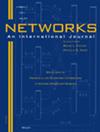灾后人道主义后勤行动中双梯队车辆和无人机路由选择的稳健优化框架
IF 1.3
4区 计算机科学
Q4 COMPUTER SCIENCE, HARDWARE & ARCHITECTURE
引用次数: 0
摘要
在灾害期间和灾后提供急救和其他物资(如肾上腺素、医疗用品、干粮、水)始终是一项挑战。如果交通、电力和通信网络发生故障,导致人们被困,无法告知自己的位置和需求,这些行动的复杂性就会增加。无人驾驶自动驾驶汽车等新兴技术的出现,可以帮助人道主义物流提供商在运输网络发生故障后,将物资送达受困人群。然而,由于电信基础设施的故障,对紧急援助的需求可能变得不确定。为了应对在基础设施网络失效的情况下向受困人群运送紧急援助的挑战,我们针对使用无人驾驶自动驾驶车辆(UAV)或无人机进行运送的双梯队车辆路由问题提出了一种新型稳健计算框架。我们将该问题表述为一个两阶段稳健优化模型,以处理需求的不确定性。然后,我们提出了一种列和约束生成方法,用于为一组给定的卡车和无人机路线生成最坏情况下的需求场景。此外,我们还受列生成方法的启发,开发了一种分解方案,可启发式地为一组需求场景生成无人机航线。最后,我们将分解方案与列和约束生成方法相结合,以确定卡车(第一梯队车辆)和无人机(第二梯队车辆)的稳健路线、受影响社区的服务时间以及援助物资的交付数量。为了验证我们提出的算法,我们使用了一个模拟数据集,旨在重现 2017 年 "玛丽亚 "飓风过后波多黎各不同地区的紧急援助请求。本文章由计算机程序翻译,如有差异,请以英文原文为准。
A robust optimization framework for two‐echelon vehicle and UAV routing for post‐disaster humanitarian logistics operations
Providing first aid and other supplies (e.g., epi‐pens, medical supplies, dry food, water) during and after a disaster is always challenging. The complexity of these operations increases when the transportation, power, and communications networks fail, leaving people stranded and unable to communicate their locations and needs. The advent of emerging technologies like uncrewed autonomous vehicles can help humanitarian logistics providers reach otherwise stranded populations after transportation network failures. However, due to the failures in telecommunication infrastructure, demand for emergency aid can become uncertain. To address the challenges of delivering emergency aid to trapped populations with failing infrastructure networks, we propose a novel robust computational framework for a two‐echelon vehicle routing problem that uses uncrewed autonomous vehicles (UAVs), or drones, for the deliveries. We formulate the problem as a two‐stage robust optimization model to handle demand uncertainty. Then, we propose a column‐and‐constraint generation approach for worst‐case demand scenario generation for a given set of truck and UAV routes. Moreover, we develop a decomposition scheme inspired by the column generation approach to generate UAV routes for a set of demand scenarios heuristically. Finally, we combine the decomposition scheme within the column‐and‐constraint generation approach to determine robust routes for both trucks (first echelon vehicles) and UAVs (second echelon vehicles), the time that affected communities are served, and the quantities of aid materials delivered. To validate our proposed algorithms, we use a simulated dataset that aims to recreate emergency aid requests in different areas of Puerto Rico after Hurricane Maria in 2017.
求助全文
通过发布文献求助,成功后即可免费获取论文全文。
去求助
来源期刊

Networks
工程技术-计算机:硬件
CiteScore
4.40
自引率
9.50%
发文量
46
审稿时长
12 months
期刊介绍:
Network problems are pervasive in our modern technological society, as witnessed by our reliance on physical networks that provide power, communication, and transportation. As well, a number of processes can be modeled using logical networks, as in the scheduling of interdependent tasks, the dating of archaeological artifacts, or the compilation of subroutines comprising a large computer program. Networks provide a common framework for posing and studying problems that often have wider applicability than their originating context.
The goal of this journal is to provide a central forum for the distribution of timely information about network problems, their design and mathematical analysis, as well as efficient algorithms for carrying out optimization on networks. The nonstandard modeling of diverse processes using networks and network concepts is also of interest. Consequently, the disciplines that are useful in studying networks are varied, including applied mathematics, operations research, computer science, discrete mathematics, and economics.
Networks publishes material on the analytic modeling of problems using networks, the mathematical analysis of network problems, the design of computationally efficient network algorithms, and innovative case studies of successful network applications. We do not typically publish works that fall in the realm of pure graph theory (without significant algorithmic and modeling contributions) or papers that deal with engineering aspects of network design. Since the audience for this journal is then necessarily broad, articles that impact multiple application areas or that creatively use new or existing methodologies are especially appropriate. We seek to publish original, well-written research papers that make a substantive contribution to the knowledge base. In addition, tutorial and survey articles are welcomed. All manuscripts are carefully refereed.
 求助内容:
求助内容: 应助结果提醒方式:
应助结果提醒方式:


